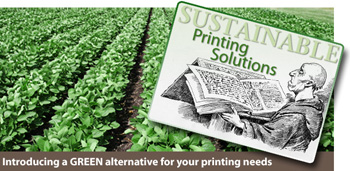February 9, 2009
Print “Green” With Soy-Based Laser Printer Cartridges

By Michael D. Shaw
Soy ink was originally developed on behalf of the newspaper industry, as an alternative to the petroleum-based inks of the day. Nearly 2000 different formulations of vegetable oil were tested before the Gazette of Cedar Rapids, Iowa printed its paper in 1987 with soy ink. Soy ink is now so widely accepted that The National Soy Ink Information Center—established in 1993 by the Iowa Soybean Association—was closed in 2005.
Some of the benefits of soy ink…
- Naturally low in volatile organic compounds, thus reducing air pollution
- Less dependence on foreign sources of oil
- Can be removed more easily from paper and the waste ink is non-hazardous, thus facilitating recycling
- The clarity of soybean oil promotes more vibrant colors
- Lower boiling point, allowing superior transfer to paper in a hot process such as copying machines or laser printers
Note that this last benefit has been known for some time, but the introduction of soy-based laser printer cartridges is quite recent. Funded in part by the Indiana Soybean Alliance’s Indiana New Ventures and Enterprises in Soy Technology (INVEST) program, the new SoyPrint cartridges have been brought onto the market by PRC Technologies, based in Standish, Maine.
The cartridges have been tested extensively for over a year, and have earned the accolades of such organizations as the University of Maine, Skidmore College, Whole Foods, and Wellesley College. In addition, higher page yields have been observed—based on controlled factory tests, printing matching documents with several of the most popular cartridges. On average, the SoyPrint cartridges yield 18.1 percent more pages than the OEM brand.
The cartridges are provided with a return tag for recycling, and customers will receive reports tracking the impact of sustainable printing. These reports include pounds of SoyPrint toner used and pounds of heavy plastic recycled.
The SoyPrint folks tell us that it takes about two liters of oil to make the one pound of toner powder required for each oil-based cartridge. Currently, U.S. businesses, institutions, and governmental agencies bodies consume more than 100 million cartridges per year. This works out to 1.3 million barrels of oil that could be saved.
Another plus is that 95% of soybeans are grown for livestock feed. Soybean oil is released during the process as a waste product, and we are now able to put it to practical use.
One of the very first dealers to offer the SoyPrint cartridges is LaserMonks, owned by Our Lady of Spring Bank Cistercian Abbey, a small monastic community located in southwestern Wisconsin.
LaserMonks was founded in 2002 as a way to generate some income to support the Abbey, focusing on imaging supplies. A portion of all revenues goes to charity. Fr. Bernard McCoy, O. Cist., Prior of the Abbey, relates the story of quick growth in the first year, and incredible demands on the time of this group of contemplative monks. What to do?
Enter the “angels,” as Fr. McCoy calls them. Under their human guise, they are better known as Sarah Caniglia and Cindy Griffith, and they now handle all aspects of the management of LaserMonks.com. “This leaves the monks free to be monks, first and foremost, along with focusing on developing the business, media relations, advertising, speaking, and even more importantly, finding creative ways to use LaserMonks income to help others,” says Fr. McCoy.
Caniglia says that switching to the SoyPrint cartridges is a “no-brainer, since here is something you are already using, and now there is an environmentally-friendly version.” What’s more, LaserMonks—in conjunction with American Forests—is planting a tree in the rain forest for every soy toner cartridge purchased.
Caniglia and Griffth wrote a book on their experiences, entitled “Lasermonks: The Business Story Nine Hundred Years in the Making.” The book highlights five building blocks to success…
1. Create a market space by reshaping the reasons why consumers purchase.
2. Provide excellent customer care by following the Rule of St. Benedict (courtesy and hospitality for all).
3. Find and capitalize on your unique strengths. (LaserMonks set themselves apart by making charity-giving an integral part of their business.)
4. Streamline operations.
5. Manage your success by balancing profits and giving, keeping customers happy and staying true to your mission.
And now the LaserMonks are helping make laser printing more Green. St. Benedict would be pleased.

